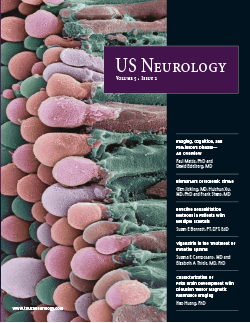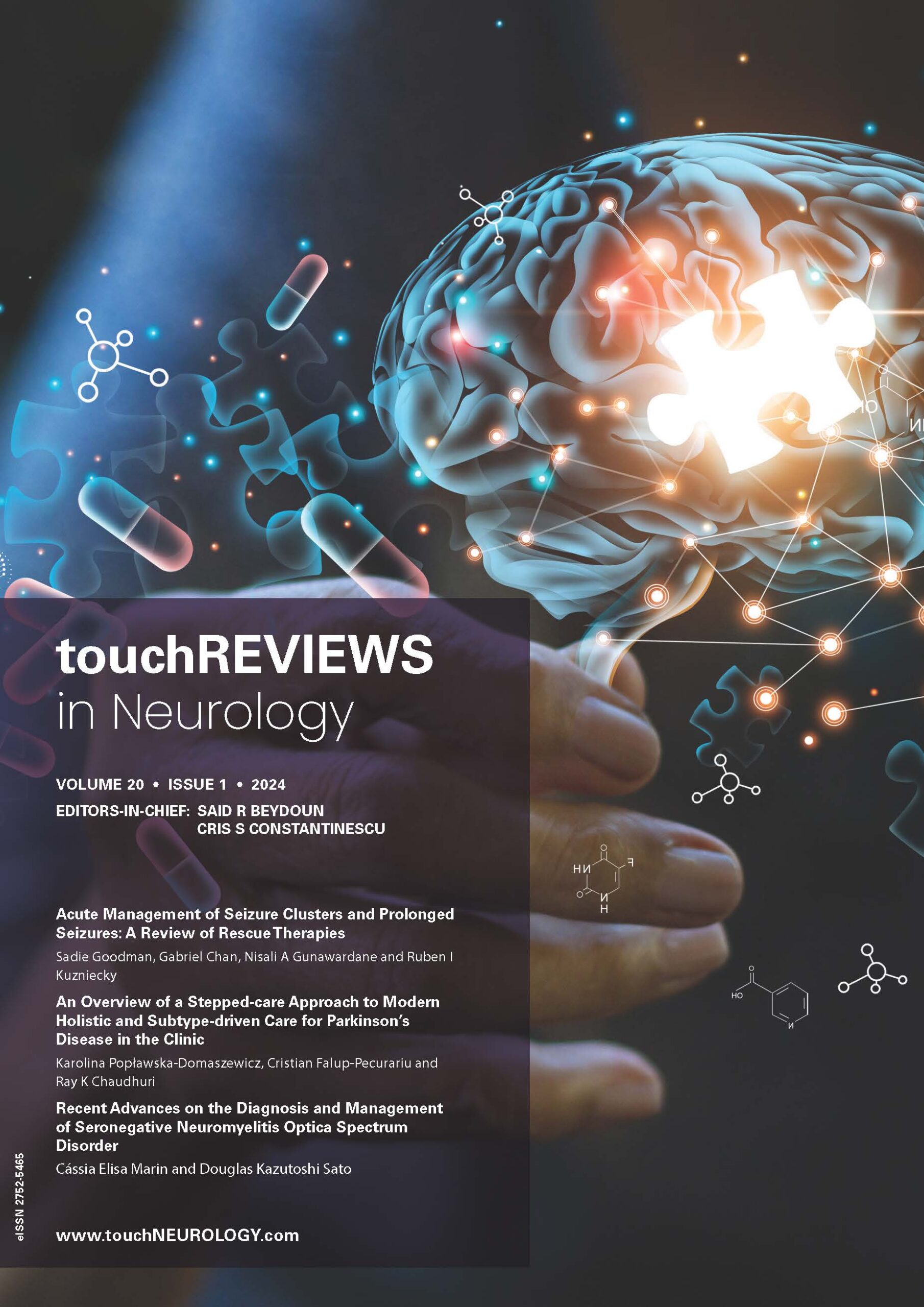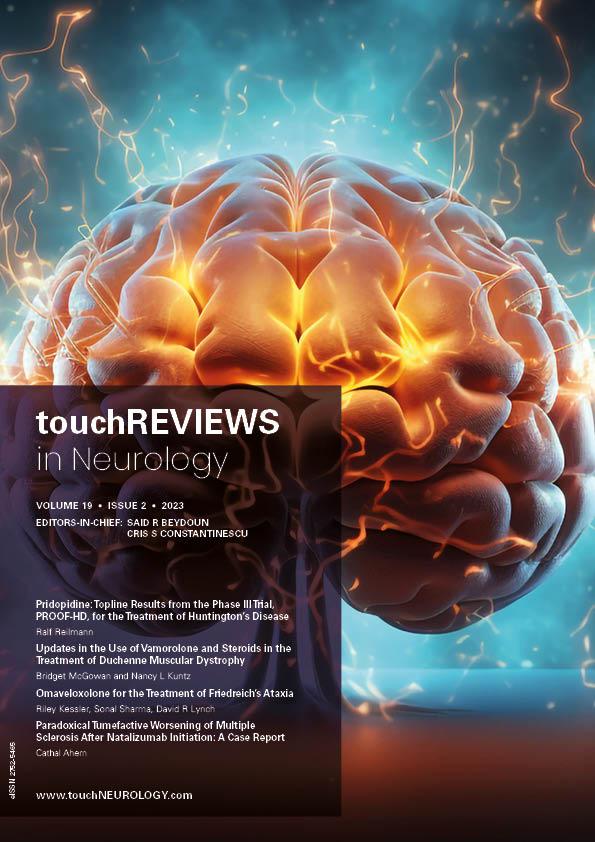
US NEUROLOGY – VOLUME 5 ISSUE 2 – FALL 2009
Foreword
Welcome to US Neurology, Volume 5 Issue 2, which reviews a broad spectrum of topics in the field of neurology and invites discussion and focus on many pertinent issues. The articles in this issue have been chosen for their relevance and significance in the dynamic and constantly evolving specialty of neurology, and contribute to our […]
Current Issues
The increasing application of neuroimaging techniques has led to the frequent discovery of cerebral white matter lesions, referred to as white matter hyperintensities (WMHs) in this article, which appear as hypodense areas on computed tomography (CT) scans or as hyperintense regions on T2-weighted and fluid-attenuated inversion recovery (FLAIR) magnetic resonance imaging (MRI) sequences. Since their […]
Delirium is a complex neuropsychiatric syndrome characterized by disturbances of consciousness, attention, cognition, and perception. It is a common condition with serious consequences. It is estimated that at admission 10–15% of elderly patients are delirious,1 and 10–40% become delirious during hospitalisation.2 Some groups of patients in particular seem to be at risk for developing a […]
Neurodegenerative Diseases
As the number of people over 65 years of age continues to rise worldwide, preserving the cognitive health of older adults has become a major societal challenge. The global prevalence of Alzheimer’s disease (AD) was estimated at 26.55 million in 2006 and is expected to quadruple over the next 40 years.1 However, research on successful […]
There is great interest in developing pharmacological compounds that function through metabotropic glutamate receptors (mGluRs) as modulators of synaptic function and that could consequently become effective therapeutic agents for several developmental and degenerative neuropsychiatric disorders. mGluRs are located perisynaptically, acting as sensors and modulators of glutamate transmission.1 This functional specificity makes them attractive pharmacological targets. […]
Parkinson’s disease (PD) is characterized by motor symptoms including resting tremor, rigidity, and bradykinesia. However, cognitive and behavioral problems in PD are common1 and can have a significant effect on quality of life.2,3 The prevalence of dementia in patients with PD has conservatively been estimated to range between 24 and 31%.4 The cognitive profile observed […]
Amyotrophic lateral sclerosis (ALS), also called Lou Gehrig’s disease, is a late-onset progressive motor neuron disease first identified in 1869 by Jean-Martin Charcot. Its incidence is approximately two cases per 100,000, with a slightly higher prevalence in men. The progressive degeneration of motor neurons in ALS leads to neuron death and loss of muscle function. […]
Clinical Features of Amyotrophic Lateral Sclerosis
Brain Trauma
Intracerebral hemorrhage (ICH) is the most dangerous and dreaded complication of thrombolytic therapy for acute ischemic stroke (AIS). The risk for symptomatic ICH (SICH) after AIS was increased from 0.6 to 6.4% after treatment with recombinant tissue plasminogen activator (rt-PA) compared with placebo in the National Institute of Neurological Disorders and Stroke (NINDS) trial.1 Despite […]
The introduction of brain tissue oxygen (PbtO2) monitoring into the neuro-intensive care unit (NICU) has created exciting opportunities for intervention but requires many questions to be answered before it can achieve widespread adoption. This article will cover the technical aspects of PbtO2 monitoring, the physiological correlates of PbtO2, the published literature on PbtO2 monitoring in […]
Stroke is a leading cause of long-term disability. Approximately 610,000 people suffer a new stroke each year in the US,1 often resulting in disability due to motor impairment and consequences of the upper motor neuron (UMN) syndrome. UMN syndrome results in both positive and negative motor effects. The positive features include muscle overactivity including spasticity, […]
Ischemic stroke remains the leading cause of adult disability in developed countries.1 Although clinical assessment is the key feature of patient management, additional tools such as biomarkers can be used to support a clinical diagnosis, identify patients at risk of disease, and help guide patient treatment and prognosis. In cerebrovascular disease, computed tomography (CT) and […]
Stroke is the third leading cause of death and the number one cause of disability in the US, with an estimated incidence of 780,000 strokes/ year.1 Approximately 10% of all strokes are hemorrhagic, with the remainder being ischemic. Within the ischemic category, two major sub-classes are recognized. Ischemic strokes occurring within large blood vessels of […]
Every year in the US there are approximately 30,000 reported cases of aneurysmal subarachnoid hemorrhage (SAH), accounting for 5% of all strokes.1–3 Mortality has been documented in the range of 20–40% and over 40% experience long-term deficits.2,4,5 Although SAH is less common than diseases such as ischemic stroke and heart attack, it affects a younger […]
Autonomic Balance
Non-invasive autonomic nervous system (ANS) assessment is often based on physiological challenges, such as the Valsalva maneuver and head-up postural change for the sympathetic nervous system (SNS) and deep breathing for the parasympathetic nervous system (PSNS). A common assumption about the ANS is that the predominant response is from stimulation of one ANS branch, and […]
Multiple Sclerosis
Multiple sclerosis (MS), which affects an estimated 400,000 people in the US, is a demyelinating disease with a variable degree of injury to axons in the brain, spinal cord, and optic nerve.1 A variety of symptoms associated with MS—such as weakness, spasticity, balance problems, and ataxia—affect functional mobility and activities of daily living. Studies have […]
Multiple sclerosis (MS) is a chronic, inflammatory, and neurodegenerative disease in which T cells cross the blood–brain barrier and attack the myelin sheath, initiating an inflammatory cascade. The consequences of these events are plaques of demyelination, gliosis, and axonal degeneration.1 MS is the leading cause of non-traumatic disability among young adults, with a total estimated […]
Epilepsy
It is estimated that epilepsy affects approximately 50 million people worldwide.1 Although conventional antiepileptic medications as well as newly developed ones have improved response in the majority of patients, it is known that up to 30% do not respond to appropriate therapy no matter how many antiepileptic drugs are administered.2 These non-responsive patients are candidates […]
Vigabatrin in Infantile Spasms Vigabatrin (VGB) was only recently approved by the US Food and Drug Administration (FDA) as monotherapy for infantile spasms (IS). Nonetheless, considerable experience is available, since VGB has been used for more than 10 years in other countries. The delay in approval in the US relates in part to its safety […]
Surgery
Post-operative cerebrospinal fluid (CFS) leakage can be a challenging and potentially hazardous problem following many complex cranial procedures.1–3 This is especially true for surgical approaches to the skull base because a watertight dural reconstruction is not always feasible and CSF pulsation waves are greatest in this location.1,3 CSF fistulas into the soft tissues at the […]
Imaging
Diffusion tensor imaging (DTI) is a new type of magnetic resonance imaging (MRI) that allows non-invasive mapping of the diffusion properties of brain water and reveals unique tissue property ‘diffusion anisotropy’.1–5 MRI can measure the extent of water diffusion along an arbitrary axis. From this measurement, it is often found that the water tends to […]
Total sleep deprivation (SD) for as little as 24 hours can result in measurable decline in cognitive performance.1 Beyond experimental settings, changes in attention, memory, and decision-making contribute to increased physician errors while on shift duty,2,3 and deficits in vigilant attention can result in fatal transport accidents.4 Despite a growing number of editorials and advisories5 […]

Trending Topic
Article highlights Multiple screening tests are available to screen patients for cognitive impairment, and the Confusion Assessment Method is a helpful test to screen for delirium in the immediate postoperative period. Medicine reconciliation and identification and removal of potentially inappropriate medications per Beer’s list are important tasks that should not be overlooked, especially during a preoperative appointment. […]
Journal Archive
touchREVIEWS in Neurology is a peer-reviewed, free-to-access, bi-annual neurology journal comprising review articles, case reports, practice guides, theoretical discussions, and original research. It features balanced and comprehensive articles written by leading authorities, addressing the most important and salient developments in the field of neurology.
Latest articles videos and clinical updates - straight to your inbox
Log into your Touch Account
Earn and track your CME credits on the go, save articles for later, and follow the latest congress coverage.
Register now for FREE Access
Register for free to hear about the latest expert-led education, peer-reviewed articles, conference highlights, and innovative CME activities.
Sign up with an Email
Or use a Social Account.
This Functionality is for
Members Only
Explore the latest in medical education and stay current in your field. Create a free account to track your learning.





